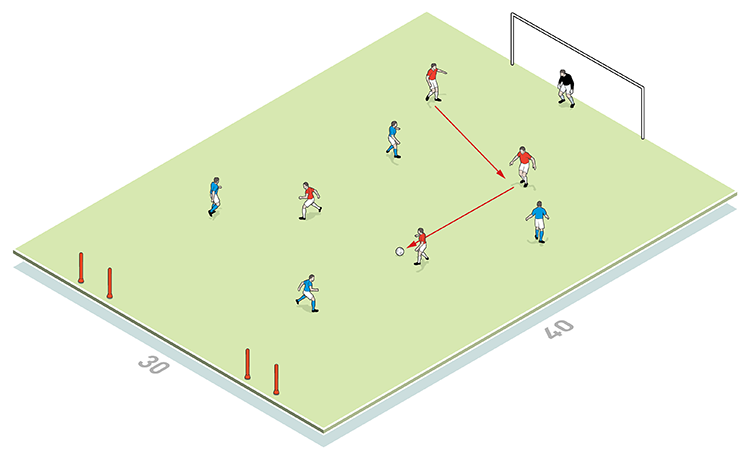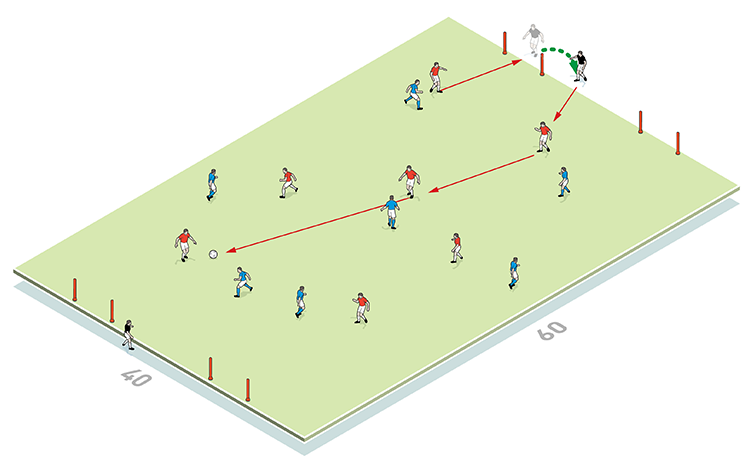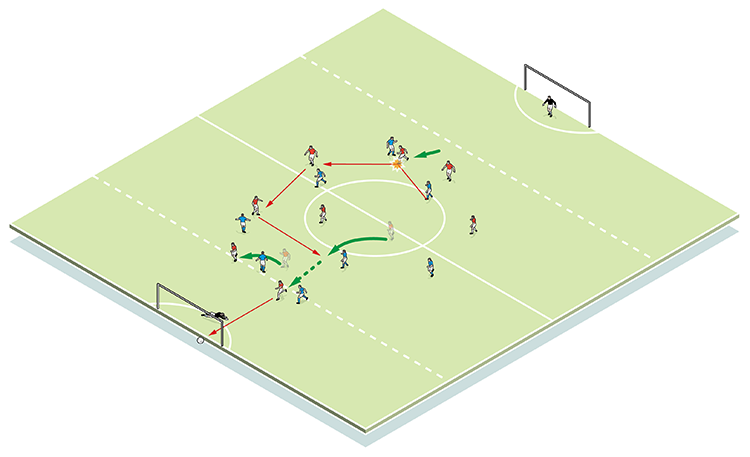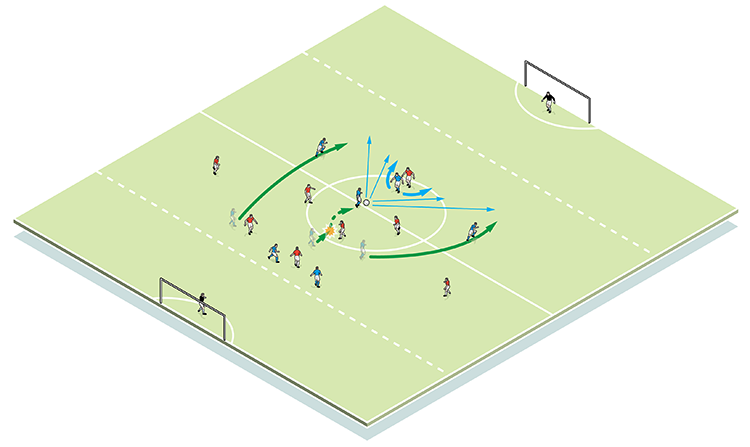You are viewing 1 of your 1 free articles
Transitions of play (offensive)
Mastering the art of stealing the ball is vital if teams are to turn defence into attack. So this session coaches players in being aware of transitions in the middle third of the pitch, teaching them how to perfect a high-energy pressing game.
| Area | Up to full pitch |
| Equipment | Balls, cones, goals |
| No. of Players | Up to 8v8 plus keepers |
| Session Time | Practices 1 and 2 12mins (3x4-minute games), 8v8 20mins |
Mastering the art of stealing the ball is vital if teams are to turn defence into attack. So this session coaches players in being aware of transitions in the middle third of the pitch, teaching them how to perfect a high-energy pressing game that holds rich rewards if done properly.
It relies on players being positive, quick on their feet, tactically aware and hard-working, and can be applied directly into match day scenarios, so is valuable as a practice that’s best done in the lead-up to a weekend game.
I’ve experienced huge reward with this set-up at both Scunthorpe United and York City, and this is a practice that can be progressed easily to ensure the learning curve continues even when the basics have been mastered.
And although we usually consider transitions from an offensive perspective, these practices are fully opposed so offer clarity and instruction whether players are being asked to fall into offensive or defensive mode.
What do I get the players to do?
Practice 1
We start with a 4v4 (1). Blues attack the big goal while reds attack the boards. If blues score a goal a fresh ball is fed in and they then attack the two small goals, and vice- versa. We are looking for quick play with intensity, especially when the ball changes hands. The set-up of this practice provokes a huge number of turnovers.
1

What are the key things to look out for?
In this practice and the ones that follow, we’re looking for teams to quickly get back into shape when a turnover happens. So whether in or out of possession, organising and communicating the new situation is imperative. But more than that, these practices are designed to encourage speed of thought and good execution of passes when the ball is at a player’s feet. None of this is possible though unless players work hard – physically and mentally – at all times.
Practice 2
Now setting up as shown (2), reds start with the ball. They have to play through one of the gates using the top keeper as a receiving target. He plays back to the same team, who turn and attack the two gates at the bottom. If reds successfully get the ball through to the bottom keeper they score a point.
2

If blues turn over play they can attack either end first – play then continues on. We are looking for positive forward play when there is a change in possession.
Practice 3
This is an 8v8 game played full-width in the space between the two penalty boxes, with an offside line 18 yards from each goal (3). Play as you would do a normal game – it’s all-in and high tempo, but two-touch in the centre circle as this is the area of the pitch in which players must move the ball around quickly.
3

Everything is game-related, including throw-ins and corners, and we can add in systems and instructions as the practice develops.
To progress, we add in a floater to create a 9v8. This gives the players different problems to solve.
We can progress it further to a 9v7 (4). In this situation the team of seven sits deep and plays on the counter-attack, while the team of nine presses high and moves the ball quickly playing two-touch, being imaginative and ambitious with their forward forays.
4

Related Files
Editor's Picks
Using the goalkeeper in build-up play
Pressing principles
Intensive boxes drill with goals
Penetrating the final third
Creating and finishing
My philosophy
Pressing initiation
Compact team movement
Defensive organisation
Coaches' Testimonials

Alan Pardew

Arsène Wenger

Brendan Rodgers

Carlos Carvalhal

José Mourinho

Jürgen Klopp

Pep Guardiola

Roy Hodgson

Sir Alex Ferguson

Steven Gerrard
Coaches' Testimonials

Gerald Kearney, Downtown Las Vegas Soccer Club

Paul Butler, Florida, USA

Rick Shields, Springboro, USA

Tony Green, Pierrefonds Titans, Quebec, Canada
Join the world's leading coaches and managers and discover for yourself one of the best kept secrets in coaching. No other training tool on the planet is written or read by the calibre of names you’ll find in Elite Soccer.
In a recent survey 92% of subscribers said Elite Soccer makes them more confident, 89% said it makes them a more effective coach and 91% said it makes them more inspired.
Get Monthly Inspiration
All the latest techniques and approaches
Since 2010 Elite Soccer has given subscribers exclusive insight into the training ground practices of the world’s best coaches. Published in partnership with the League Managers Association we have unparalleled access to the leading lights in the English leagues, as well as a host of international managers.
Elite Soccer exclusively features sessions written by the coaches themselves. There are no observed sessions and no sessions “in the style of”, just first-hand advice delivered direct to you from the coach.









